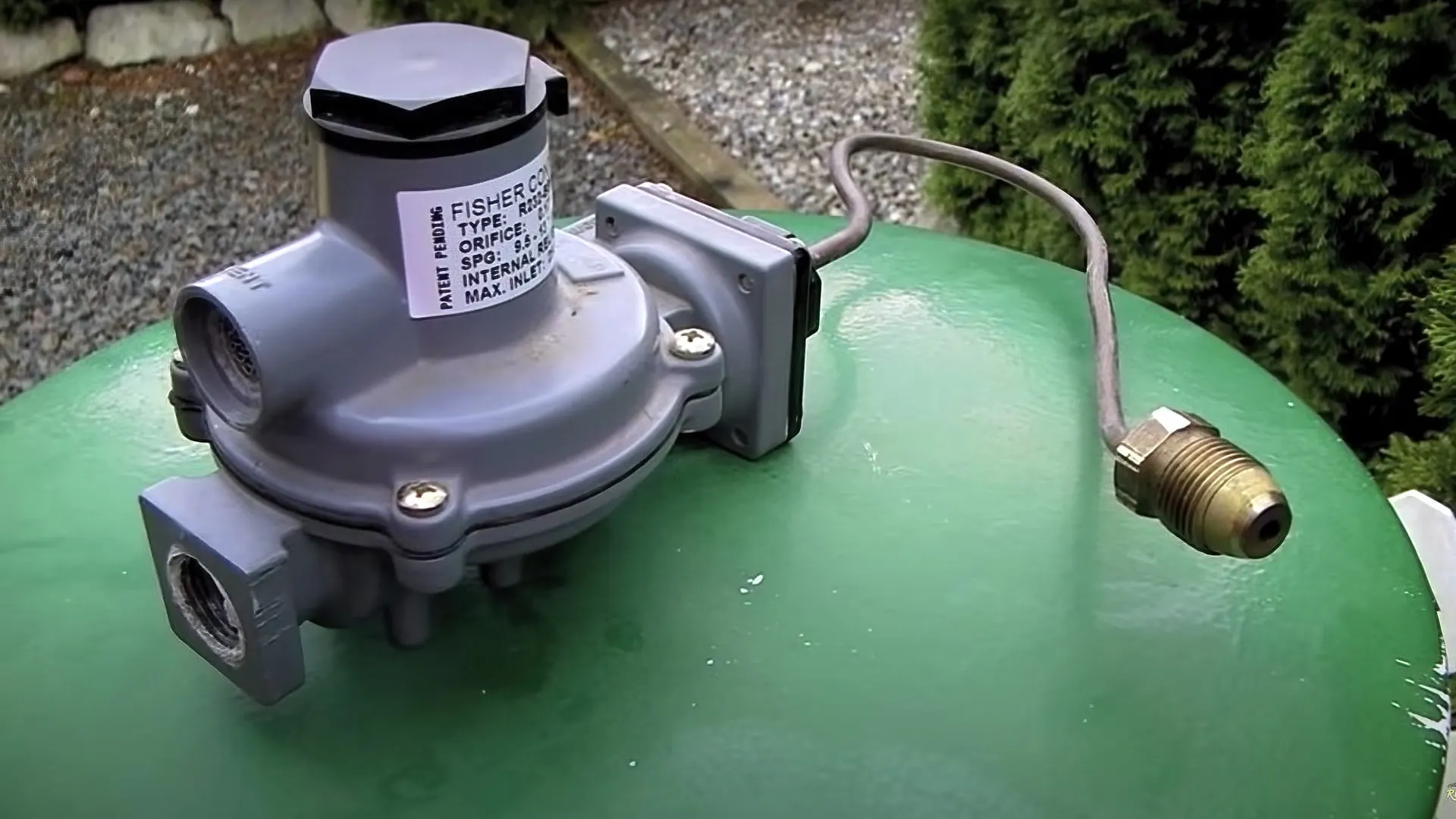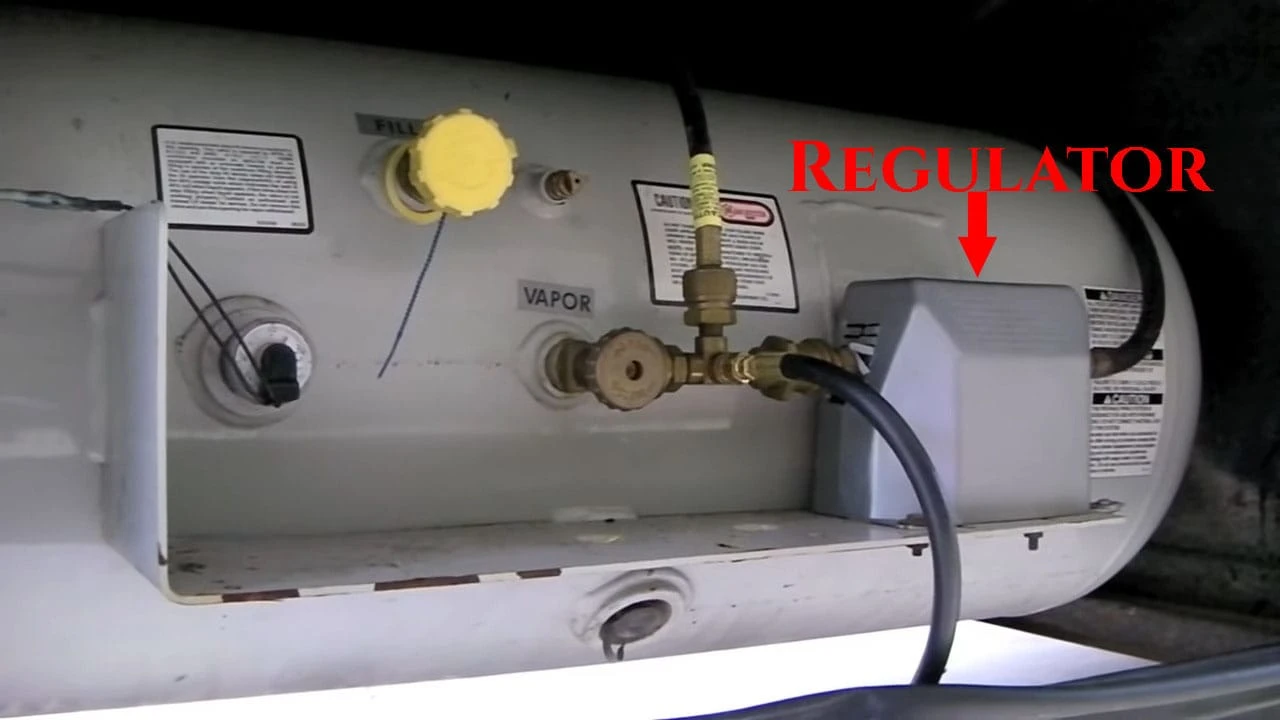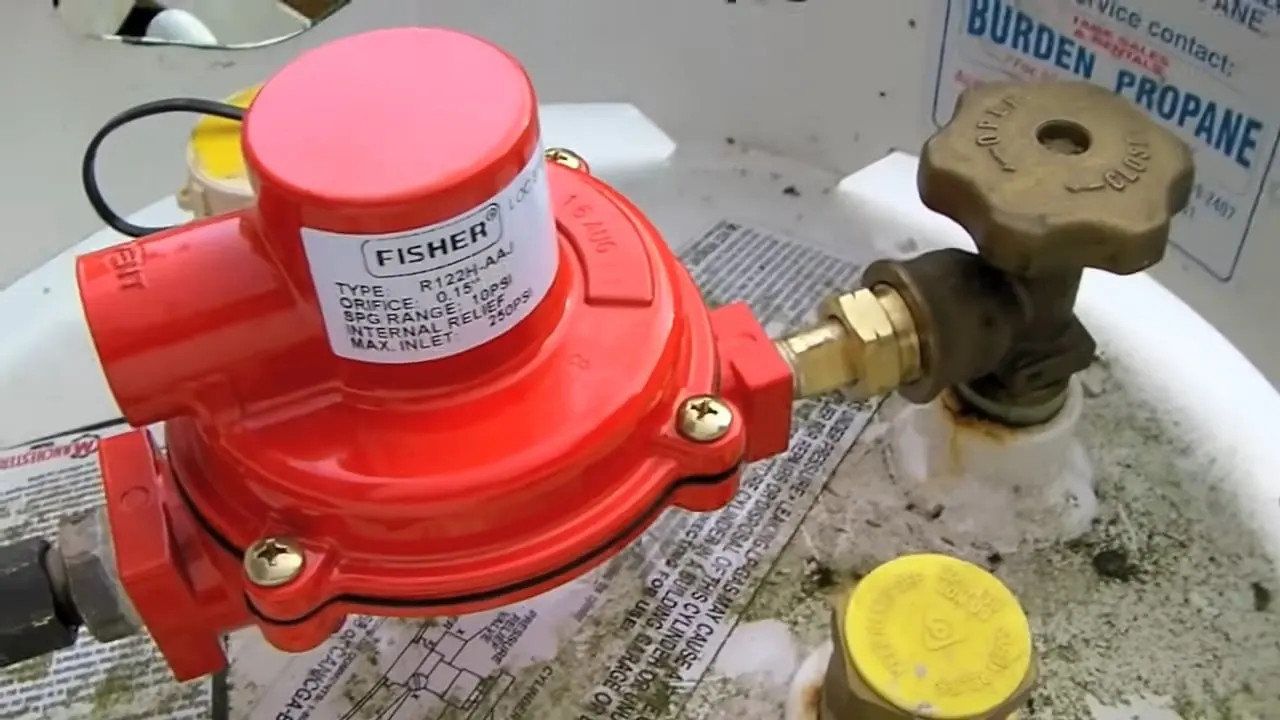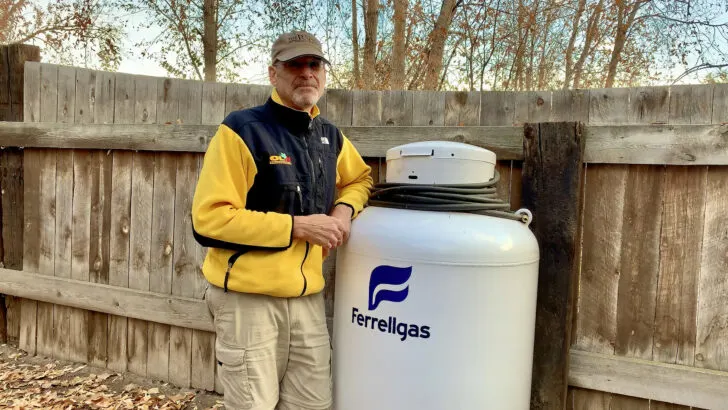Many RVers have an occasional (or frequent) opportunity or need to connect to an external RV propane connection. In fact, we’ve done so ourselves a number of times over the years.
The first time we considered doing this, we had no experience connecting to an external propane source, but we were spending the winter at a friend’s RV site in the Lower Mainland of British Columbia, and it can get pretty cold there. We were invited to connect to their large propane tank to make things easier, more convenient, and more cost-effective for us.
Using an outside propane source turned out to be a little bit more involved than we thought it would be, but it presented a great opportunity for us to learn how to hook an RV up to an external propane connection.
So, we went into RVgeeks mode, learned what we needed to know, and ultimately enjoyed the convenience of not having to worry about moving the RV every time we needed propane throughout the winter. We subsequently even produced a video about it, knowing that others might benefit from what we’d learned.
But that was a good ten years ago. We know of many RVers who spend the winter in colder locations, and who might benefit from a post dedicated to hooking an RV up to an external propane tank. So, in today’s post, we’ll show you how to connect to an external propane source, saving yourself the trouble of moving your RV every time you need propane.
-
1)
How Do You Hook Up An External Propane Tank to an RV?
- 1.1) What if My Extend-a-Stay Hose Doesn’t Reach the External Propane Tank?
- 1.2) Can I Connect One End of the Hose Directly to an External Propane Tank and the Other End Directly to the Extend-a-Stay on My RV?
- 1.3) What is an RV Propane Tank Regulator?
- 1.4) What’s This “Double Regulation” Problem I’ve Been Hearing People Warn About?
- 1.5) Can I Remove the Regulator From the RV External Propane Connection and Connect Directly to the Tank?
- 1.6) Are All Propane Regulators the Same Pressure?
- 2) Can I Use an Extend-a-Stay to Refill My RV’s Propane Tank?
- 3) Conclusion
How Do You Hook Up An External Propane Tank to an RV?
We did have experience connecting our RV’s propane tank to an external gas grill, so we already had a special piece of gear on board to enable us to do that.
We used (and still use to this day) a product called an “Extend-a-Stay” which may also be referred to as a “Stay-a-While” (or “Stay-a-While Deluxe”) and indeed these are aptly named. It allows us to do two things: 1) Connect our barbeque grill to our RV’s onboard propane tank, and 2) Attach our RV itself to an external propane tank to augment/extend our onboard propane supply.
Bear in mind that in order to install a product like this you’ll need to have good access to your RV’s onboard propane tank.
- Includes propane tee.Fit Type: Universal Fit
- Includes 5' auxiliary tank hose and 12' additional appliance hose
What if My Extend-a-Stay Hose Doesn’t Reach the External Propane Tank?
The short hose that comes with the Extend-a-Stay may be perfectly sufficient for many RVers. But the run to the propane tank we connected to was quite long – about 25 to 30 feet. So, we had to add additional sections of propane hose to extend the length.
Extend-a-Stay hose fittings are designed to connect to an external propane bottle for a barbeque grill. In order to connect to an extension hose, we had to visit a local propane dealer to purchase a couple of fittings to convert the Extend-a-Stay hose fitting from the propane grill style connection over to a standard propane extension hose.
The 15′ lengths of propane extension hose we bought are available on Amazon.
Can I Connect One End of the Hose Directly to an External Propane Tank and the Other End Directly to the Extend-a-Stay on My RV?
Depending on the location of the tank you’re connecting to, and therefore the length of the hose, the answer might be yes. In our case, it was no, and required one additional piece of gear added into the line, as we’ll explain below.
Using the Extend-a-Stay to connect to a small portable propane tank (think of the typical barbecue grill bottle) is likely the most common way RVers use this great device to extend their stay without having to move their RV to refill with propane. But we were connecting to a much larger tank that was not only immovable, but was located quite far away from our propane compartment.
If you’re staying in a cold winter climate, you may be considering doing this exact same thing as well. Some RV parks in cold locations that are open year-round offer external propane tank connections as an option, with large tanks located right on each site. But there’s an important caveat about doing that we’ll explain below. So keep reading…
What is an RV Propane Tank Regulator?
A propane regulator controls the flow of LP (liquid propane) gas from the tank to the RV’s appliances. The regulator essentially reduces the very high pressure coming from the propane tank itself to the much lower gas pressure required by RV appliances. But this is the thing… they come in various PSI ratings, and are not all the same.
The output of a propane regulator can be indicated in one of two ways. The first is one that most people are very familiar with: PSI, which is the abbreviation for “pounds per square inch” and is used in well-known applications such as the pressure in your car, RV or bicycle tires.
The second way of indicating pressure (typically for gases) is less well known: Inches Water Column, which is also sometimes referred to as “WC” or “Inches of Water”. WC is defined as the pressure exerted by a column of water of 1 inch in height at defined conditions. It’s not critical to understand precisely how WC is measured, but if you’d like to know more about it, you can read more here.
The propane inside any propane tank (even a small one) is under very high pressure… typically between 100 to 200 PSI. That high pressure is required to ensure the propane gas remains in a liquid state (hence its other name: LP, or liquid propane).
But you could never connect any appliance directly to a propane tank without first reducing that high pressure through the use of a regulator. That’s because RV appliances, and typical portable barbeque grills, require about 11″ WC to operate, (which equals only about 0.4 PSI)… far lower than the pressure inside the tank.
What’s This “Double Regulation” Problem I’ve Been Hearing People Warn About?
When we initially hooked up to the external propane connection on the large propane tank at the RV site, we were getting a very minimal flow of propane. There was barely enough propane flow to ignite a single burner on our cooktop. We sure weren’t going to be able to heat our RV, or water for a shower. We had a good tight connection to the tank, with no leaks, but something was wrong.

Not all RV propane tank regulators are the same! This one prevented our connection to an external RV propane tank from working!
We contacted a local propane dealer, and here’s what we learned:
The regulator on the tank we were connecting to had a label stating that it was rated for an output of 9.5” – 13” WC. What a coincidence —our RV’s appliances run on 9.5” – 13” WC! So it should have been perfect, right? Not necessarily.
Because our Extend-a-Stay is installed right at the outlet of our RV’s onboard propane tank, where the LP is under full pressure, it’s on the upstream side of our RV’s built-in regulator. As mentioned, the 100-200 PSI inside a propane tank is FAR too high for an RV, so it always has to be regulated. Like most every RV, our onboard regulator is a 9.5” – 13” WC model.
The use of TWO 9.5” – 13” WC regulators in the same line (one at the big external tank, and one at the RV) equals double regulation. This is critical to understand if you’re connecting to a larger propane tank with a regulator. You do need a 9.5” – 13” WC regulator, but only one of them! The two very-low-pressure regulators in series (remember that 11″ WC equals only about 0.4 PSI) prevents enough propane from reaching the appliances, so they won’t work.

This is the regulator on our RV’s onboard propane tank. With one 9.5” – 13” WC regulator here on the RV, and a second 9.5” – 13” WC regulator on the external propane tank, we were “double regulating” resulting in insufficient flow of propane for our appliances.
Can I Remove the Regulator From the RV External Propane Connection and Connect Directly to the Tank?
This idea sure seemed to make perfect sense to us. If two regulators are preventing enough gas from reaching the RV’s appliances, why not just remove one? You’d be using the regulator at your RV’s onboard propane tank and simply connecting directly to the propane tank at the RV site without a second regulator in the mix.
But, after asking us how long the run of hose would be from the external tank to the RV, our helpful propane dealer advised against this plan.
We were running a very long (two 15′ extensions, for a total of 30′) propane hose from the external propane tank on the RV site to our Extend-a-Stay. It turns out that running propane through a very long hose at very high pressure, and in cold temperatures, presents a problem.
High-pressure propane over a long run in cold temperatures will cause oil to develop inside the hose, and this would gum up the regulator on our RV’s onboard propane tank. This would have been a very bad idea in the cold of winter when we needed plenty of propane to heat our RV.
A few years later we’d forgotten about the “oil in the long propane hose” warning, and experienced the problem first-hand when our grill got all gummed up. That’s why we updated our barbecue grill extension hose.
So if installing a regulator at the tank won’t allow enough propane to run the RV, and removing the regulator at the tank can cause oil build-up, what’s an RVer to do?!
Are All Propane Regulators the Same Pressure?
No!
All propane regulators are not the same, and therein lie the answers to our past issues, and some of the general confusion about propane regulators. Regulators have specs for their INPUT pressure as well as their OUTPUT pressure.
When you hear about the dreaded “Double Regulation!” problem… using two different regulators (ones that have properly matched input and output pressures) doesn’t count! It’s hard to explain, and some people who watch our video about this still insist it won’t work, even though we’ve been doing it just fine for over a decade!
Here’s the secret…

Installing this new regulator rated for 10 PSI on the big tank solved ALL the issues we had with our external RV propane connection.
Under the tutelage of our trusty local propane dealer, we bought a different regulator for the external tank. The reason is that this new regulator dropped the tank pressure down to 10 PSI… and below 10 PSI, oil won’t form inside a long run of hose. The oil build-up issue only occurs at higher pressures.
BUT (and this is the big source of confusion), 10 PSI is far higher than 9.5” – 13” WC (remember that 11″ WC equals only about 0.4 PSI). That means this new regulator is about 20 times higher pressure than the one that prevented us from getting enough propane to run our appliances. The 9.5” – 13” WC onboard regulator that sits downstream of this one gets plenty of flow and pressure, and it works like a charm with no oil build-up. It’s basically a step-down regulator.
So, if you have any similar type of issue when attempting to make an RV external propane connection, consider the tank’s regulator as a potential cause of the issue, and a more appropriate regulator as a potential solution.
We made the following video about this exact scenario ten years ago, and we’ve included it here in case you’d like to review the process visually in greater detail.
Can I Use an Extend-a-Stay to Refill My RV’s Propane Tank?
No. It’s important to understand that the purpose of this product or any product like it is NOT to REFILL your RV’s onboard propane tank. This is easy to misunderstand so we wanted to make it clear.
This piece of gear allows you to connect your RV to an external propane source such as an auxiliary propane cylinder or large tank. So, if your RV’s onboard tank runs out of propane, for example, this RV external propane connection allows you to connect to another propane tank like we did. This allows you to use the propane in that external tank to continue to heat your RV and your water, and run your propane stove.
And here’s a great additional tip — Don’t wait until your onboard tank is empty before running off the external tank! We kept our onboard tank full as a backup and ran off the external tank first. That tip could be extra useful if you’re using small, portable grill-style tanks with your Extend-a-Stay.
When one of the small tanks runs out, you can switch back to your onboard propane supply (by re-opening the valve on your RV’s built-in tank) and stay nice and warm until you can get the portable tank refilled. Once that’s done, you can switch back to running off of the external tank… leaving your onboard propane as the backup.
Important Note: you should only leave ONE of the two tanks (onboard or external) turned on at any one time. The “Extend-a-Stay” does not have any kind of automatic switch-over capability… you have to manually control which tank you want supplying propane, and only one can be on at a time.
Conclusion
We hope this helps you to understand the process of making an RV external propane connection so that you can stay warm and have plenty of hot water and fuel for cooking throughout your winter RVing experiences.
Geek Out with Us Every Week
Join our newsletter to learn about all things RV-related. Every week we offer free tips, tricks, product reviews, and more to our online community of RVers. So, whether this is your first time on the road or you’re a seasoned expert, we’d love for you to geek out with us!



RAYMOND C CALDWELL
Sunday 26th of September 2021
Why doesn't the Extend a Stay tee into the RVs distribution system downstream of the onboard regulator? Especially since its not intended to refill the onboard tank.
TheRVgeeks
Sunday 26th of September 2021
Hi Raymond. Good question. The reason you can’t do what you’re suggesting (install the Extend-a-Stay downstream of the onboard regulator) is because you’d then be pressurizing the RV’s propane system with full, high-pressure propane. It’s not designed for that and could cause serious damage. Since there’s no other regulator inline between the external tank and the extend-a-stay, it has to go upstream of the RV’s onboard regulator… so that regulator can reduce the pressure properly for all other appliances.
TJL
Saturday 25th of September 2021
One slight tweak. The pressure inside the tank is dependent on temperature only (the vapor pressure), unrelated to how full the tank is.
Bill J.
Saturday 25th of September 2021
I have an Extend-a-Stay. I dislike the small 1/4" fitting that I have to thread each time I use it. Has anyone figured out a good quick-disconnect option?
Ssc
Monday 30th of January 2023
@TheRVgeeks, the quick connects are rated for 250 psi. They are designed for high pressure straight out of a tank for like the buddy heaters and such that have built in regulators.
Ssc
Monday 30th of January 2023
@Bill I purchased 2 set of quick connect with valves made in from Amazon for like $15 each. Put one threaded straight onto the 1/4 nipple and the other on the end of the hose. It comes with the male connections as well so I just used collar and made a double sided male. Quick connect the male to camper side then hose quick connect n open both valves makes easy, quick and safe. Just don’t lose the double male like I did once lol.
TheRVgeeks
Saturday 25th of September 2021
Hey Bill. We know what you mean about that small connection... it is a bit of a nuisance, but we think it may be intentional to ensure you have to use the correct hose to connect (so you don't make a mistake). We don't have a suggestion for you on a solution (we only use ours occasionally, so it's not as big of a pain), but do have one word of advice: whatever you get/use, be sure it's rated for high-pressure propane. Since that hose/connection is between the tank and the Extend-A-Stay, it's getting the full pressure contained in the tank and could be an issue for a lot of adapters/connectors that are only rated for low-pressure.